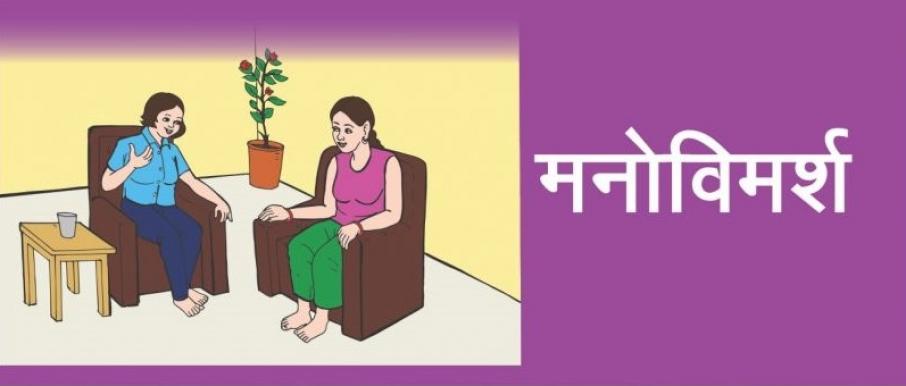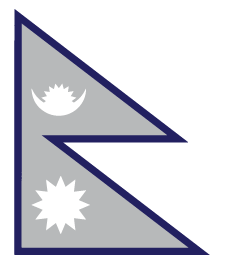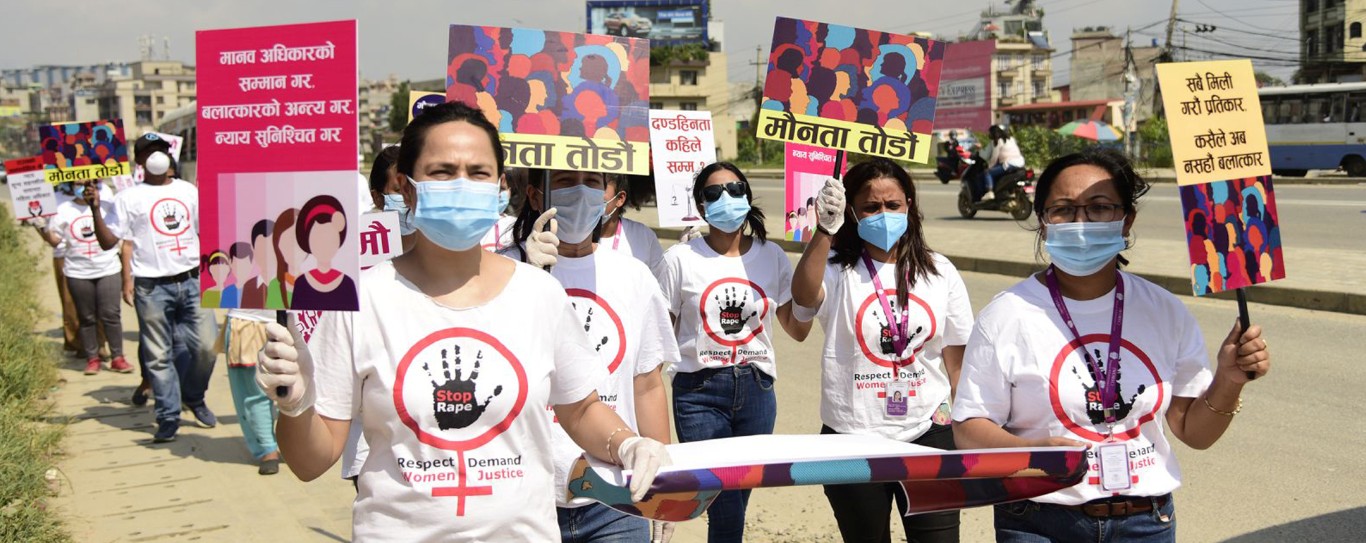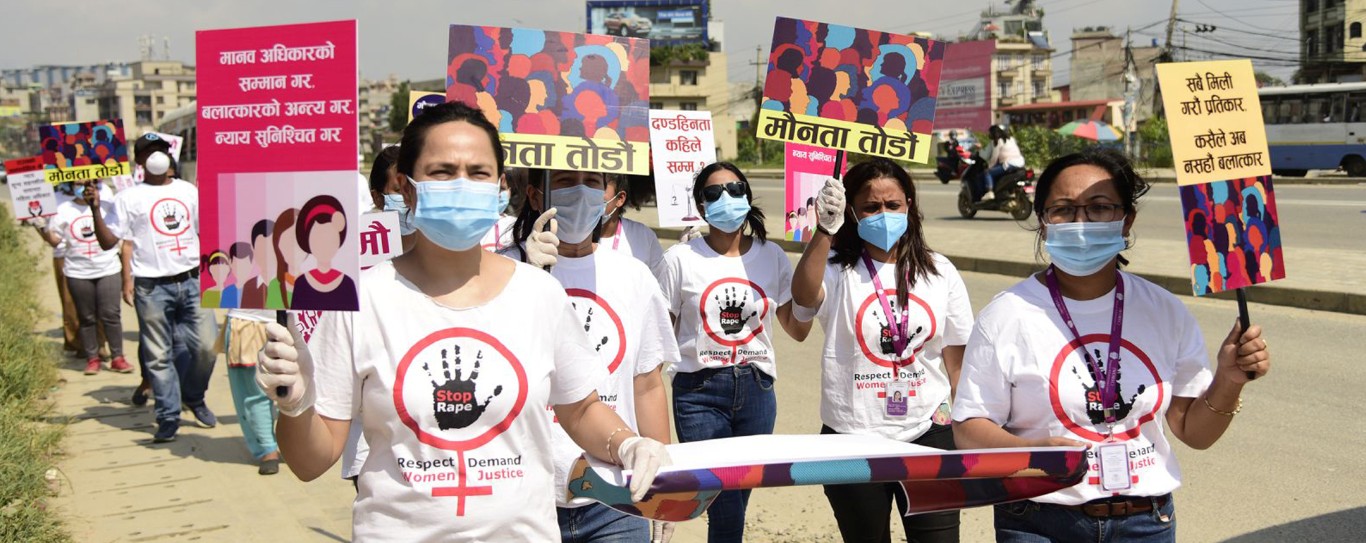AAKRITI GHIMIRE
KATHMANDU, Dec 5
When Sangita first received a threatening message, she was 18—during her last year of high school.
Then it continued.
Some read like ‘when you turn twenty-five and that’s when we will meet for the first time,’ she said. And it had a warning also.
“You are going to be mine and I will ruin your life if you even think of being with anyone else,” the messages read.
Hoping that the letters would stop if she ignored them, Sangita paid no heed to those, only to be cyberstalked and harassed for six years.
“The intensity of the harassment changed and gradually worsened over time. In the beginning, the letters and Facebook messages described what he liked about me. And when I didn’t respond, he started threatening to kill my family,” said the 24-year-old medical student whom the Post is identifying as Sangita to protect her privacy. “Over the years, he’s called me persistently, sent me messages from multiple fake Facebook accounts calling me names and using derogatory languages, and also has threatened me with rape and death.”
The mental anguish that Sangita had to go through isn’t an individual experience.
Threats of physical attack. Explicit and pornographic photos. Body shaming. Explicit messages. Cyberstalking. Hate speech. These are the kinds of abuse and harassment girls are often subjected to.
Young persons cannot be expected to deal with such trouble without support. But there’s some sort of help available now.
“Mostly 17- to 22-year-old young girls have reached out to us seeking support and pro bono legal consultation to deal with online harassment,” said Dipasa Bista, 24, lead of the #NotAnymore campaign.
#NotAnymore campaign, started in 2020 by a group of friends who recognised the pervasiveness of online harassment among their circles, has received over 500 complaints so far. It is a social campaign to stand in solidarity against online sexual harassment.
To address such online threats and harassment, the Nepal Police has set up Cyber Bureau, but many say approaching the bureau itself comes with a risk of further victimisation.
Nonetheless, the bureau does receive complaints.
In the fiscal year 2020-21, as per Cyber Bureau data, 55 percent of the victims of online harassment were females, 39 percent males, and 6 percent were identified as others.
Around 5 percent of the victims were below the age of 18.
In the last three months, from mid-August to mid-November, 1,268 cases of online harassment have been filed at the Cyber Bureau, which comprises 44 percent of the total cases filed last fiscal year.
At this rate, the total cases of cybercrime registered by the end of the fiscal year 2021-22 will see a 76.4 percent increase from the last fiscal year.
While this indicates an increase in the occurrence of online harassment, many cases also go unreported.
Many are unaware of the help they can seek while others are not quite sure—or lack the confidence—whether they should report the case.
Anusha, 24, was harassed by her teacher in college. From inquiring about her virginity and sexual behaviours to sending her nude images through Facebook messenger, she became a victim of online harassment.
Anusha found herself without any help or resources to deal with the situation and was unable to take any legal action against her teacher because she wasn’t aware of the help she could seek.
“I knew what was happening was wrong but the teacher-student dynamic put me in an extremely difficult position, and I didn’t know where to go or who to talk to. I was so lost and traumatised. I hadn’t consented to any of such advances or such messages,” said the graduate of Social Work, whom also the Post is identifying as Anusha to protect her privacy.
“There were no resources available—neither in college nor at home—teaching us what harassment is, how it manifests online and what we can do.”
In a research study conducted by Body and Data, a digital rights organisation, participants reported experiencing online violence in various forms.
According to Body and Data, 52 percent of the participants faced receiving unwanted sexually explicit messages, 46 percent had experienced abusive comments; 45 percent name-calling; 39 percent hate speech; 36 percent abuse and/or shaming a woman for expressing views that are not normative, for disagreeing with people and also for refusing sexual advances, and 13 percent had received direct threats of physical or sexual violence.
Only 10 percent of the respondents had reported such violence to a legal system.
Cyber Bureau in Nepal, however, only looks into cases of online harassment governed under Section 47 of the Electronic Transactions Act, 2063.
For a case to be registered at the Bureau, according to the Act, the content displayed or published in the electronic media should “violate” the prevailing law, or may “be contrary to the public morality or decent behavior,” or may “spread hate or jealousy against anyone or which may jeopardise the harmonious relations subsisting among the peoples of various castes, tribes, and communities.”
According to legal experts, Nepal’s legal system isn’t legally and socially equipped to handle the gravity of criminal cases that take place in cyberspace. They identify three major issues within the whole makeup of the Bureau—lack of sufficient infrastructure to conduct investigations, legal shortcomings, and a lack of sensitivity in handling issues.
“Firstly, the Bureau lacks sufficient infrastructure to conduct proper investigations. Secondly, all cases of harassment are grouped under one broad umbrella, that has a greater potential for injustice,” says Rashtra Bimochan Timalsena, assistant director of National Law College.
Thirdly, said Timalsena, the statute of limitations comes as a hindrance, which has been set at 35 days.
Victims are unable to process their experiences in the given timeframe, say legal experts, according to Timalsena.
“The thirty-five day timeline is extremely limiting. Most of the crimes take place through social media which means we need to reach out to the headquarters of the platform—Facebook, Instagram, Viber—for further information. It takes about 15-20 days for them to respond, and once we get the IP address, then we start to track. And not all cases can be solved by then,” says Inspector Buddhi Subedi at the Cyber Bureau.
A minimum of three months is necessary for any cyber crime investigation, according to Subedi. “The Bureau has been constantly raising this issue at the Police Headquarters and the Home Ministry,” he said.
In addition to a non-victim-centric legal system, there is a lack of an emotionally supportive environment at the Bureau. Harassment survivors are further victimised by the socio-cultural and legal environment while filing complaints and during investigations.
Sangita’s case is a testimony to the trivialisation of issues and a lack of sensitivity at the Bureau.
“When I approached the police station at Baneshwar, they refused to take the case and said that we should instead invite the harasser to meet us and help him understand how his actions affected me, politely,” said Sangita.
She was appalled by the compassion the officers extended to the perpetrator, she said.
As opposed to being sympathetic towards her while she shared her account of online violence, she had to fight the police officers at the Bureau to even consider her case.
“When I took 60 pages of evidence—screenshots of conversations from all the fake accounts starting 2018—to the Cyber Bureau after the first lockdown, they said they only looked at the past 35 days of evidence and said they didn’t find enough evidence to file a case,” says Sangita.
The thirty-five days of evidence included derogatory and foul language used against Sangita.
“Why was the focus on whether a perpetrator’s behavior is contrary to public morality as opposed to the fact that my safety is threatened, and that it affects my mental health?” she said.
Had Sangita not fought for her rights at the Bureau, the case would neither have been registered, nor proceeded.
Lack of sensitivity among officials at the bureau has been a major concern, according to her.
“While there are officers who have dealt with cases with seriousness, many officers demonstrate a lackadaisical attitude towards cases of online harassment,” she told the Post, adding, “In fact, about 50 percent of the cases have problematic investigations.”
Officers in the Bureau do not undergo any special training, other than those prescribed for the civil police.
“We only undergo basic training that lasts 18 months and crime investigation training. It includes courses on victim handling and approaching such situations, but there’s no extra training that we undergo,” said Subedi, the inspector.
The lack of mental health first aid courses, victim-focused training and gender sensitivity training are reflected in the interactions between victims and the officials.
Victim-blaming at the sites of justice—police stations and Cyber Bureau—is only reflective of Nepali society’s unequal gender structures.
“Victims have already gone through a huge battle by the time they decide to file a case. When they are blamed for their decisions and actions, women are further vilified and treated as sexual objects even at sites of justice,” explains sociologist Lalita Bashyal.
Questions targeted towards women—asking why they sent pictures in the first place, or why they interacted with men in the first place, asking if they had thought of consequences of their actions, how it affects their family’s honor and their marriage prospects—are frequent and angle towards victim-blaming, according to Bashyal.
Cyber Bureau is soon undergoing a complete restructuring, from upgrading the existing technology to installing advanced equipment with the assistance of the South Korean government. However, the agenda doesn’t address sensitising the officials at the Bureau, thus far, according to Subedi.
Despite the need for reforming the cyber laws and system of operation in the Bureau to address the rapidly increasing crimes in the online space, stakeholders also don’t seem to have prioritised it.
As many as 314 events are being organised by national and international organisations all across Nepal as part of the 16 days of Activism against Gender-Based Violence (GBV), an annual international campaign to increase awareness and galvanise advocacy efforts against GBVs. It takes place annually from November 25 until December 10.
However, not a single event this year is being organised to talk about online harassment or on raising awareness on it.
Two days after the Bureau agreed to take Sangita’s case, the harasser deleted all his fake Facebook accounts and apologised.
“However, very recently, he messaged a male friend of mine saying that if the latter associates with me, he will cut off the latter’s private part and sell it to the university canteen. We sent the screenshots to the Cyber Bureau, but we didn’t hear back,” said Sangita. “But I want him to know that I will take legal action and haul him before the court if he persists with these actions.”
If you wish to seek any consultation with regard to online harassment, you can email connect.notanymore@gmail.com, or you can message them on Facebook or Instagram.
The article originally appeared in Kathmandu Post and is republished with the permission from author.
https://kathmandupost.com/national/2021/12/06/online-harassment-rife-but-largely-ignored-as-system-fails-to-recognise-it
Feminism is central to the social, cultural and political movement for equality around the globe but how important is the role of feminist knowledge generation and retention to sustain the feminist movement? Is feminist resource center an answer? We explore.
Feminist movement and Nepal
In Nepal, from Yogmaya Neupane who ignited the rage against discrimination at the civic level in 1917, to the downfall of over a century long oligarchy Rana regime – made possible through women’s participation, feminist movement has played a significant role in shaping Nepal’s history.
The Department of Women Development was established in 2000 under the Ministry of Women, Children and Social Welfare which was an achievement of the women's unified efforts through years of advocacy and movement. The leaders of Nepal's feminist movement, having recognized the need for an alliance to achieve rights and equality, established the Inter-Party Alliance of Women (IPWA) which was formed in 2006 as a common political mechanism for gender justice. IPWA is considered as the milestone in Nepal's feminist movement.
After the restoration of democracy, the reinstated parliament on May 20, 2006, unanimously adopted a resolution that incorporated four major points as women's equal right to descent, property, participation and law against violence against women (VAW). The resolution was followed by amendment of other various discriminatory laws - one being the issuance of passports for women under 35 with their father or husband's consent.
Feminist movement in Nepal has entered into the agendas carried by the third wave of global feminist movement. Convention on the elimination of all forms of discrimination against women (CEDAW) has been the focus with issues of recognition to women which transcribes challenges and policy implementation towards right to participation, descent, property, reproductive health, citizenship and more.
Gender equality is key to overall wellbeing of women, and researches[1] have shown that support for gender equality is high among women with higher education. However, Nepal’s documentation of feminist movement and its achievements are slight, scattered and unattainable.
Nepal has high prevalence of gender-based violence (GBV) despite its significant progress in gender equality and women empowerment over the years. There is still a long way for Nepali women to establish an equal footing with their male counterparts, but possible only with increased knowledge and experience which requires constant engagement and discussion to further feminist campaigns in the country.
Feminist knowledge generation and discord
Feminist knowledge generation is one of the significant aspects to advance shared achievements of the feminist movement of a country. Adoption and ratification of the international conventions and programs have provided Nepal an opportunity to both contribute and take advantage of the common plan of actions. CEDAW, the Beijing Declaration and Platform for Action (BPfA) and the Sustainable development Goals (SDGs) have been the pillars for some of the prevalent reforms on inclusion, gender equality and women empowerment as enshrined by the Constitution of Nepal 2015.
However, the discourse on how these binding conventions and urgent call for actions were contextualized and interpreted in Nepali context, have not been found recorded as part of knowledge resource.
Similarly, in 2020, the parliament endorsed the government’s Citizenship Amendment Bill to the Citizenship Act of 2006. It states that children born to a Nepali father and a foreign-born mother are eligible for citizenship by descent, while those born to a Nepal-born mother and a foreign-born father will be granted naturalized citizenship, with less privilege.
The frustration with the endorsement was expressed immediately. The feminist fraternity along with media and academics raised voice against the unequal treatment of women in the bill. Many articles were published, and virtual discussions took place but, assembling of materials for a comparative study would prove extremely difficult due to information being scattered.
Despite profound history of feminist movement, countless reforms and prevailing issues of feminism, Nepal lacks sustained effort to document the achievement, processes and struggles of Nepali women and their contribution to the feminist movement.
Need for an integrated feminist resource center
There have been efforts to resource knowledge around gender equality and feminism in the past through media outreach, academic researches and numerous consultations; however, not having an integrated platform of resources has proven difficult for individuals, organizations or networks interested in feminism to access them.
“A feminist resource center will help advance the evidence based advocacy that Nepal needs. It is important to document feminist knowledge as the concept of gender equality is not static. The gender discourse keeps evolving depending on the lived experiences and new researches based on evidence.” said Dr. Chandra Bhadra, Professor Emeritus of Gender Studies, Tribhuvan University, who played a crucial role in establishing Gender Studies in Nepal’s curriculum.
Department of Gender Studies at Tribhuvan University was established in 2009 that contributed to launching Master’s degree in gender studies. This created avenues for researchers and authors for more research and knowledge generation in the context of feminism and women development in Nepal. This has been an historic win for gender and feminist academics and researchers, however, it only catered to the students and academics, not the public in general.
After the establishment of National Women Commission in 2010, organizations working on women and gender issues took the charge of civic awareness and launched various campaigns to define and re-define the demands of feminist movement in Nepal. Similarly, empowerment and inclusion being the core agenda, both national and international development organizations have been building up platforms that explain their works, impacts and achievements. But again, issues of segregation and individualistic working patterns affect the overall feminist movement in Nepal. It is crucial that there is a well co-ordinated, healthy partnership-led resource platform for all to discuss, dissect, inform, share and grow together.
Moreover, it is equally essential to capture the voices of those who are mostly underrepresented even within the feminist discourse. “While talking about feminist focused resource space, we need to be mindful that there isn’t segregation of women’s issues and LGBTIQ issues. It is important to understand that they are inter-linked. Issues around intersectionality such as class, race, identity and sex should also be considered when it comes to generating, discussing, and sharing feminist issues,” said Rukhshana Kapali, a transgender female human rights activist.
Gender justice and women rights in Nepal would be achieved only by changing culture, attitude and behavior at a personal, professional and policy level. It is also critical to consciously define, structure, retain and disseminate knowledge to sustain the feminist movement, on the basis of captured knowledge, policy reviews and revisions of laws and regulations, and bringing forward the local lived experiences of rural feminist champions.
The feminist resource portal will provide the right hub that will continue even after the actors fade away. It will provide individuals, institutions, policy makers, researchers, educators and gender advocates to further the feminist movement through an integrated platform where anyone can access knowledge on gender and women, feminism and feminist movement, on GBV and VAW, practices in other countries, on policies and laws, and most importantly on the shared agenda that women's right is human right.

मनोविमर्श भनेको के हो ?
व्यक्तिको आफ्नै जीवन र वरिपरिको समाजमा घटिरहने विभिन्न खाले घटनाहरूले व्यक्तिको सोचाई र जीवनमा फरक पार्दछ । व्यक्तिको व्यवहार समाजले चाहेअनुरुपको हुँदा ऊ समाजमा राम्ररी बस्न सक्छ । तर समाजले चाहे अनुसारको व्यवहार नभएमा ऊ समाजमा राम्ररी घुलमिल हुन नसकी मनोसामाजिक समस्या देखिन सक्छ । जसले व्यक्तिको मन र समाजबीच तालमेल नमिलेर शारीरिक, मानसिक, भावनात्मक रुपमा व्यक्तिलाई प्रभाव पार्दछ । यसले गर्दा विभिन्न मनोसामाजिक समस्याहरु जस्तै तनाव हुनु, निन्द्रा नलाग्नु, रिस उठ्ने जस्ता विभिन्न समस्या देखिन्छ । यस्तो बेलामा व्यक्तिको मनोसामाजिक समस्याको समाधान गर्न व्यक्ति र मनोविमर्शकर्ता विच हुने योजनाबद्ध कुराकानी र छलफल नै मनोविमर्श हो। सामाजिक परिवेशमा बिभिन्न कारणबाट उत्पन्न हुने असहज परिस्थिती जस्तै बिपदको प्रभाव, मानव सृजित घटना, सशस्त्र द्वन्द, लैंगिक हिंसा, बेरोजगारी, आर्थिक समस्या वा अन्य कुनै कारणले असुरक्षित महसुस गरेका व्यक्तिहरुको मनोसामाजिक समस्या समाधान गर्न मनोविमर्श सेवा प्रभावकारी हुन्छ ।
मनोविमर्श किन आबश्यक छ ?
मानिसहरु विभिन्न खाले समस्याहरुबाट निरन्तर गुर्जिरहेका छन् । प्राकृतिक प्रकोप जस्तै भुईचालो, बाढी, पहिरो, कोभिड १९ जस्तो महामारीले सृजित समस्या, ससस्त्र द्वन्द जस्ता परिस्थितीसँग हामीले भोगेका छौं । विभिन्न सामाजिक प्रथा, लैंगिक भेदभाव, जातिय भेदभाव र यी भेदभावका कारणले निम्त्याईएको हिंसा, भने जस्तो रोजगार तथा अवसर नपाउनुले पनि व्यक्तिको मनोसामाजिक अवस्थामा गहिरो प्रभाव परेको छ । त्यस्तै गरेर हाम्रो सामाजिक संरचनाको कारण, महिला माथि हुने भेदभाव, बलात्कार र अन्य यौनजन्य घटना, आफ्नै श्रीमान् र परिवारबाट हुने हिंसाको कारण महिलाहरुले विभिन्न मनोसामाजिक समस्या भोग्नु परीरहेको छ । महिलाहरुले परिवारमा आफूलाई परेको मनोसामाजिक समस्या भन्ने अवस्था छैन । भने पनि परिवारको सदस्यले त्यसको गोपनियता राख्छ र समाधान गर्न सहयोग गर्छ भनेर महिलाहरुले विश्वास गरिहाल्न सक्दैनन् । यदि कसैले यसको बारेमा थाहा पाए त्यस्तो व्यक्तिलाई फरक नजरबाट हेरिन्छ । महिलाहरुलाई मनोसामाजिक समस्या भएमा कँहा गएर उपचार लिने भन्ने बारे जानकारी नहुन सक्छ । त्यसैले मनोविमर्श केन्द्र सञ्चालन गर्नु आबश्यक छ ।
मनोविमर्श सेवा कसले लिन सक्नेछन् ?
समुदाय तथा परिवारमा आफ्ना समस्या तथा मनोभावनाहरु स्वतस्फूर्त रुपमा व्यक्त गर्न नसकि अझ जटिल परिस्थितीमा रहेका व्यक्तिहरुले सहज, सुरक्षित र गोपनिय रुपमा आफ्ना पीडा तथा भावनालाई व्यक्त गर्ने वातावरण नभएको व्यतिmहरुले मनोविमर्श सेवा लिन सक्नेछन् ।
Top Contributors
Upcoming Events
Editor's Pick
- Emergence and Practice of Feminist Knowledge in Nepal General
- Walls Turned Sideways Are Bridges Reports
- No Justice without Reparation: Why Rape Survivors Must Have a Right to Compensation General
- Child Marriage Prosecutions in India - Case Law Analysis of Actors, Motives and Outcomes 2008-2017 General
- Feminist Leadership best practices - Sangat Best Practices





